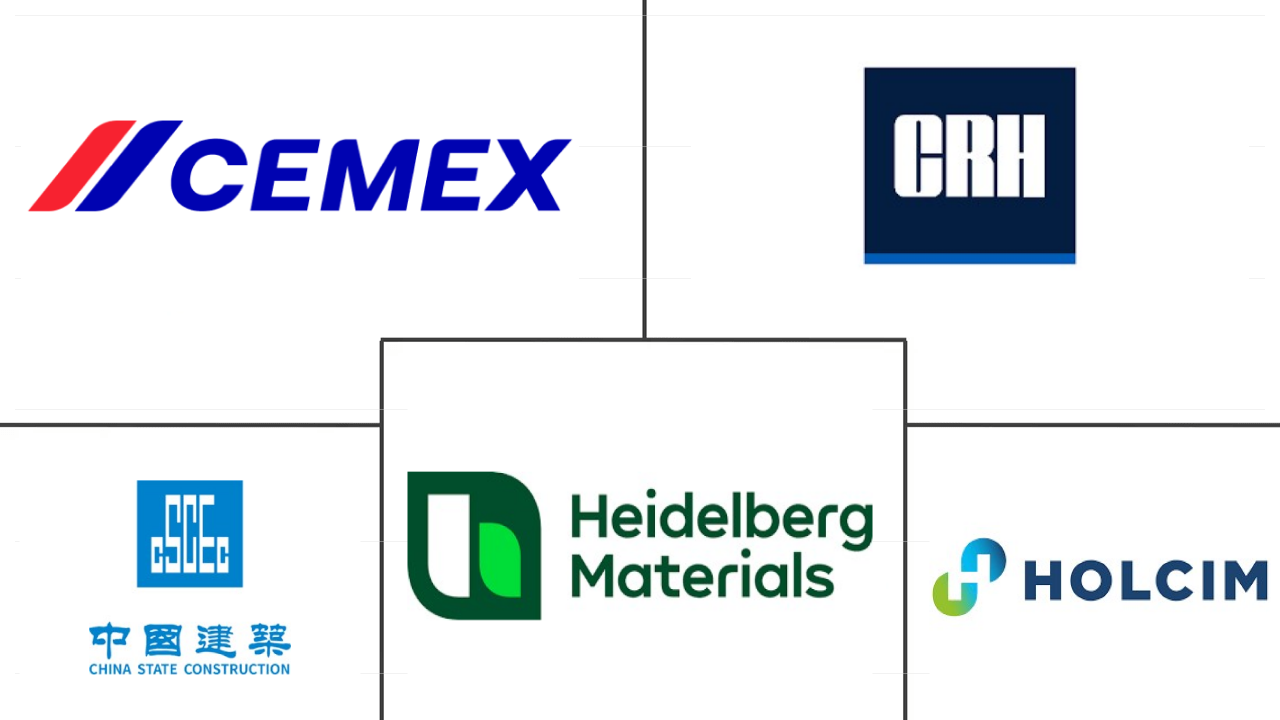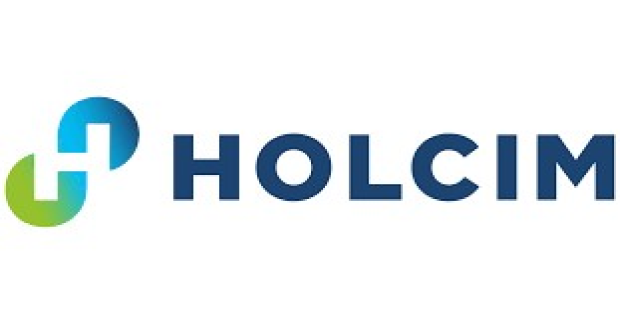Market Size of high-strength concrete Industry
|
|
Study Period | 2018 - 2030 |
|
|
Market Volume (2024) | 668.4 Million Cubic meters |
|
|
Market Volume (2030) | 948.4 Million Cubic meters |
|
|
Largest Share by End Use Sector | Infrastructure |
|
|
CAGR (2024 - 2030) | 6.00 % |
|
|
Largest Share by Region | Asia-Pacific |
Major Players |
||

|
||
|
*Disclaimer: Major Players sorted in no particular order |
High-Strength Concrete Market Analysis
The High-Strength Concrete Market size is estimated at 668.4 million Cubic meters in 2024, and is expected to reach 948.4 million Cubic meters by 2030, growing at a CAGR of 6.00% during the forecast period (2024-2030).
668.4 Million
Market Size in 2024 (Cubic meters)
948.4 Million
Market Size in 2030 (Cubic meters)
4.45 %
CAGR (2018-2023)
6.00 %
CAGR (2024-2030)
Largest Market by End Use Sector
42.26 %
volume share, Infrastructure, 2023
Due to the escalating demand for infrastructure in developing economies and increasing consumption of high-strength concrete in major infrastructure projects, the infrastructure sector holds the largest share.
Fastest Market by End Use Sector
7.30 %
Projected CAGR, Residential, 2024-2030
With the growing usage of high-strength concrete for applications such as the construction of high-rise structures for columns, shearwalls, foundations, etc., the residential sector is projected to witness the fastest growth.
Largest Market by Region
51.91 %
volume share, Asia-Pacific, 2023
Due to the growing construction industrial activity in the region coupled with the increasing demand for high-strength concrete in countries like China, India, Japan, and South Korea, the region has dominated the market.
Fastest Market by Region
6.48 %
Projected CAGR, Asia-Pacific, 2024-2030
Due to rising investments in infrastructure projects, government initiatives, fast-paced urbanization, and industrialization, Asia-Pacific is expected to witness the fastest growth.
Leading Company
2.22 %
market share, Holcim, 2022

Due to the strong foothold in the construction industry offering a wide range of concrete products coupled with a strong distribution channel, the company has occupied the largest share.
The demand for high-strength concrete is expected to rise rapidly in the global residential sector
- In 2022, global consumption of high-strength concrete dipped by 2.32% compared to the previous year. The commercial sector saw the steepest decline, with a drop of 7.24%, primarily due to sluggish growth in construction volumes. As most economies stabilized and regained pre-pandemic levels in 2023, the sectors experienced high growth in construction activities, leading to an estimated increase of 6.1% in the overall global consumption of high-strength concrete compared to 2022.
- High-strength concrete offers several advantages over regular concrete, including enhanced load-bearing capacity, reduced weight, and heightened durability. Its compatibility with precast elements further streamlines construction, saving both time and money. Therefore, high-strength concrete is most preferred in the infrastructure sector compared to the rest of the sectors.
- The industrial & institutional sector is the second-largest consumer of high-strength concrete. Within this sector, the ready-mix variant dominates, accounting for 45% of the total volume in 2022. The precast type is projected to witness the highest CAGR of approximately 7% during the forecast period.
- In the residential sector, high-strength concrete is extensively used in high-rise buildings. Its exceptional load-bearing capabilities make it an economical choice for transferring vertical loads to a building's foundation. With global urbanization on the rise and a growing preference for vertical housing, the residential sector is anticipated to witness the fastest CAGR of 7.25% in high-strength concrete consumption during the forecast period.
The global high-strength concrete market is poised for growth, largely driven by the expanding commercial and residential sectors in Asia-Pacific
- The global consumption of high-strength concrete witnessed a decline of 14 million cubic meters in 2022 compared to the previous year. Asia-Pacific accounted for a significant portion of this decline, with a drop of 21 million cubic meters in 2022 compared to 2021. However, the scenario was set to change in 2023, as the surge in high-rise construction projects is projected to boost global consumption by approximately 36 million cubic meters.
- Asia-Pacific consistently leads in construction projects, spanning from small to mega-scale. A case in point is India, which, as of May 2022, had the highest number of infrastructure projects in progress or underway, with a cumulative value exceeding USD 25 million, surpassing all other nations. China and Australia secured the 3rd and 4th positions, respectively, in this ranking. These figures underscore the Asia-Pacific's dominance as the primary global consumer of high-strength concrete.
- Following the Asia-Pacific, Europe emerges as the second-largest market for high-strength concrete. Notably, Russia, Germany, and Italy stand out as pivotal players, collectively accounting for 48% of Europe's demand in 2022. The infrastructure, industrial, and institutional sectors are the major drivers, accounting for over 60% of the region's consumption.
- Asia-Pacific is poised to be the fastest-growing market for high-strength concrete, with a projected volume CAGR of 6.5% during the forecast period. This growth is fueled by rising demand from the region's burgeoning residential and commercial sectors. For instance, the commercial sector's new floor area is anticipated to witness a robust CAGR of 5.2% in volume during the forecast period.
High-Strength Concrete Industry Segmentation
Commercial, Industrial and Institutional, Infrastructure, Residential are covered as segments by End Use Sector. On-site Mix, Precast, Ready-Mix are covered as segments by Product. Asia-Pacific, Europe, Middle East and Africa, North America, South America are covered as segments by Region.
- In 2022, global consumption of high-strength concrete dipped by 2.32% compared to the previous year. The commercial sector saw the steepest decline, with a drop of 7.24%, primarily due to sluggish growth in construction volumes. As most economies stabilized and regained pre-pandemic levels in 2023, the sectors experienced high growth in construction activities, leading to an estimated increase of 6.1% in the overall global consumption of high-strength concrete compared to 2022.
- High-strength concrete offers several advantages over regular concrete, including enhanced load-bearing capacity, reduced weight, and heightened durability. Its compatibility with precast elements further streamlines construction, saving both time and money. Therefore, high-strength concrete is most preferred in the infrastructure sector compared to the rest of the sectors.
- The industrial & institutional sector is the second-largest consumer of high-strength concrete. Within this sector, the ready-mix variant dominates, accounting for 45% of the total volume in 2022. The precast type is projected to witness the highest CAGR of approximately 7% during the forecast period.
- In the residential sector, high-strength concrete is extensively used in high-rise buildings. Its exceptional load-bearing capabilities make it an economical choice for transferring vertical loads to a building's foundation. With global urbanization on the rise and a growing preference for vertical housing, the residential sector is anticipated to witness the fastest CAGR of 7.25% in high-strength concrete consumption during the forecast period.
| End Use Sector | |
| Commercial | |
| Industrial and Institutional | |
| Infrastructure | |
| Residential |
| Product | |
| On-site Mix | |
| Precast | |
| Ready-Mix |
| Region | ||||||||||||||
| ||||||||||||||
| ||||||||||||||
| ||||||||||||||
| ||||||||||||||
|
High-Strength Concrete Market Size Summary
The high-strength concrete market is poised for significant growth, driven by its superior properties such as enhanced load-bearing capacity, reduced weight, and increased durability, making it a preferred choice in the infrastructure sector. The market is experiencing a resurgence as global economies stabilize post-pandemic, with construction activities ramping up. The industrial and institutional sectors are major consumers, with the ready-mix variant leading in volume. The residential sector is also witnessing increased adoption, particularly in high-rise buildings, due to urbanization and the demand for vertical housing solutions. The Asia-Pacific region dominates the market, fueled by extensive construction projects in countries like India, China, and Australia, while Europe follows as a significant market, with countries like Russia, Germany, and Italy driving demand.
The market landscape is characterized by a fragmented structure, with major players such as CEMEX, CRH, CSCEC, Heidelberg Materials, and Holcim holding a modest share. Recent strategic acquisitions by these companies, such as CRH's acquisition of Buzzi Unicem's ready-mix operations in Ukraine and Holcim's expansion in the UK and Poland, highlight ongoing efforts to strengthen their market positions. The global market is expected to continue its upward trajectory, supported by increasing demand from the residential and commercial sectors, particularly in Asia-Pacific, where new construction projects are set to add substantial floor area by the end of the forecast period.
High-Strength Concrete Market Size - Table of Contents
-
1. MARKET SEGMENTATION (includes market size, forecasts up to 2030 and analysis of growth prospects.)
-
1.1 End Use Sector
-
1.1.1 Commercial
-
1.1.2 Industrial and Institutional
-
1.1.3 Infrastructure
-
1.1.4 Residential
-
-
1.2 Product
-
1.2.1 On-site Mix
-
1.2.2 Precast
-
1.2.3 Ready-Mix
-
-
1.3 Region
-
1.3.1 Asia-Pacific
-
1.3.1.1 By Country
-
1.3.1.1.1 Australia
-
1.3.1.1.2 China
-
1.3.1.1.3 India
-
1.3.1.1.4 Indonesia
-
1.3.1.1.5 Japan
-
1.3.1.1.6 Malaysia
-
1.3.1.1.7 South Korea
-
1.3.1.1.8 Thailand
-
1.3.1.1.9 Vietnam
-
1.3.1.1.10 Rest of Asia-Pacific
-
-
-
1.3.2 Europe
-
1.3.2.1 By Country
-
1.3.2.1.1 France
-
1.3.2.1.2 Germany
-
1.3.2.1.3 Italy
-
1.3.2.1.4 Russia
-
1.3.2.1.5 Spain
-
1.3.2.1.6 United Kingdom
-
1.3.2.1.7 Rest of Europe
-
-
-
1.3.3 Middle East and Africa
-
1.3.3.1 By Country
-
1.3.3.1.1 Saudi Arabia
-
1.3.3.1.2 United Arab Emirates
-
1.3.3.1.3 Rest of Middle East and Africa
-
-
-
1.3.4 North America
-
1.3.4.1 By Country
-
1.3.4.1.1 Canada
-
1.3.4.1.2 Mexico
-
1.3.4.1.3 United States
-
-
-
1.3.5 South America
-
1.3.5.1 By Country
-
1.3.5.1.1 Argentina
-
1.3.5.1.2 Brazil
-
1.3.5.1.3 Rest of South America
-
-
-
-
High-Strength Concrete Market Size FAQs
What is the current Global High-Strength Concrete Market size?
The Global High-Strength Concrete Market is projected to register a CAGR of 6.00% during the forecast period (2024-2030).
Who are the key players in Global High-Strength Concrete Market?
CEMEX, S.A.B. de C.V., CRH, CSCEC, Heidelberg Materials and Holcim are the major companies operating in the Global High-Strength Concrete Market.

